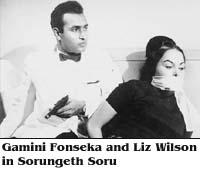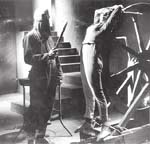 |
 28th June 1998 |
Front Page| |
Jamis Banda and other odysseysPart TwoBy Richard BoyleThe chances are that those who have seen Sorungeth Soru will remember the film for the simple reason that it is so outrageous. The last of Mike Wilson’s three features, it is generally considered to be his worst. It often evokes strong feelings, usually negative ones. Significantly, even its producer, Sesha Palihakkara, confesses that it is a film he is ashamed of. However, is this general assessment an altogether fair one? Is the film just a cynical rip-off of Ian Fleming’s James Bond character, miraculously reincarnated in Ceylon and complete with sadomasochistic tendencies? Is it a piece of mindless entertainment? Or does its militaristic atmosphere, nihilism, and scenes of torture and violence, neatly - if unwittingly - foreshadow the future direction of the country? It has been suggested that by late 1964, after the success of Ran Muthu Duwa and to a lesser extent, of Getawarayo, Mike Wilson’s interest in Sinhala cinema was beginning to evaporate. This was probably due to several reasons, not least of which was the fact that Stanley Kubrick’s project, Journey Beyond the Stars (eventually called 2001: A Space Odyssey) was being conceived at this time. Arthur Clarke had been in New York for months grappling with the story for the film, and that of the novel, in collaboration with Stanley Kubrick, and had been sending Mike Wilson tantalising (and possibly distracting) reports on the scope and scale of the project. On signing a contract with Kubrick, Arthur Clarke wrote enthusiastically to Mike Wilson: “I still can’t quite take it in... Stan, who is a ball of fire, and mad keen on the project, wants to shoot for release at Christmas 66 (however, it ended up being Easter 68). So we have to get cracking on the script immediately.” Arthur Clarke continued by expressing his faith in the viability of the project: “I can’t think of anyone who will have less difficulty finding a distributor - he’ll have to beat them off at the door!” “Went to the studio yesterday and emerged stunned,” Arthur Clarke wrote later on. “This is no longer a $ 5,000,000 movie. I think the accounts department has thrown in its hand; the guess I heard was $ 10,000,000/. The framework of one set has started. It’s not really a vital scene and takes place inside a 750 foot diameter disc-shaped space-station. Yet they’re building a full-size section of the rim - it’s a circular one 150 feet long and 30 feet wide - the size and shape of a ski-jump. The models have been roughed out, and there are hundreds of drawings and paintings, some beautifully detailed. In about six weeks, things should be very exciting.” Mike Wilson became peripherally involved in 2001: A Space Odyssey, conjured up ideas here and there as well as making more practical contributions as we shall see. However, Arthur Clarke advised him in a letter not to let this interfere with his “Serendib activities, which must still take precedence”. Serendib Productions was set up at the time of the making of Ran Muthu Duwa with Arthur Clarke, Mike Wilson and Sesha Palihakkara as partners. Serendib had a film unit that had to earn its keep and Arthur Clarke, as a major investor in the venture, was shrewd enough to realise that continuity of work was essential.
The plot was predictable, derivative, and simplicity itself. There were these neo-Nazis, you see, who were making an atom bomb with which to hold the world to ransom. The mastermind and arch-terrorist was to be played by Rodney Jonklaas, and his henchman, the brain surgeon/scientist who turned people into radio-controlled robots, (with artificial arms ending in crabsclaws in order to grip the atom bomb), was to be played by Chris Greet. The lead role of Jamis Banda, the intrepid secret agent who eventually infiltrates their evil scheme, was a natural one for the emergent Gamini Fonseka. Jeevarani Kurukulasuriya played the leading lady who is kidnapped by the terrorists and has to be rescued, while Liz Wilson played the evil temptress who tries her hardest to seduce “Agent Sri 007.” Although Mike Wilson originally wanted Peter Donaldson to work behind the scenes on the film, “he decided that as I was an actor, I’d better have a part... not any old part, but chief villain, usurping Rodney Jonklaas! It was after a couple of bottles of beer and some devilled prawns that I suggested - half in jest - playing the son of Adolf Hitler and Eva Braun!” This plot element has shades of Franklin J. Schaffner’s 1978 movie, The Boys From Brazil, about it. “Mike jumped at the idea and the script was adapted. I arrived from the sea from a submarine in local dress and wearing a false moustache and beard (which kept coming unstuck in the humid heat!) To prove how nasty I was, I bought a canary from a street vendor and took it to my lodgings where I fed it to my pet persian cat!” At the end of the film Adolf junior escapes and vanishes back into the sea, perhaps meant to reappear one day in a never-to-be-realised sequel.
The directorial discipline exhibited by Mike Wilson on Ran Muthu Duwa had, by all accounts, largely disappeared by the time of Sorungeth Soru. Sesha Palihakkara considers Mike Wilson to have been an “intuitive director” during his early period, “very economical, never quarrelsome, and had a great sense of humour.” During the filming of Sorungeth Soru, however, he would often disappear after lunch, never to return to the set or location until the next call-sheet. By early 1966 the filming was still not complete and Mike Wilson went on a trip to London to pursue some international film projects. Arthur Clarke, who was by this time back in Ceylon, became increasingly worried about the lack of progress with the film and it was decided to continue without Mike Wilson. Actors were asked to write their own lines (the script being a somewhat ad hoc affair) and Tissa Liyanasuriya took over as director. Arthur Clarke wrote to Mike Wilson in March 1966: “The film is going well - they have finished with Jeevarani and Paul _who leaves the island in a French yacht in only two days! If I hadn’t started production again we would have been in a mess. Shooting should finish in about three weeks, dubbing should take another two, so you should assume that you will be working with Ti (Titus Totawatte) around mid-April”. Arthur Clarke went on to advise him that the latest James Bond film, From Russia With Love, was to open in Colombo that week. (Up to that time, only three Bond films had been released - Dr. No (1962), From Russia With Love (1963), and Goldfinger (1964). “Presumably June is the earliest release possible forJamis Banda? Arthur Clarke inquired of the mercurial director, somewhat optimistically, for a few weeks later he had joined Mike Wilson in England and they had become engrossed in the problem of how to make the Dawn of Man sequence in 2001: A Space Odyssey as convincing and realistic as possible. This included visiting zoos to study the behaviour of apes, as Arthur Clarke recorded in The Lost Worlds of 2001 (1972): “April 23 (1966), drove with Roger Caras and Mike Wilson to an excellent private zoo near Nuneaton, which had all the big apes. Mike had a very hard time filming the chimps, who kept dashing around and throwing themselves at the camera. I was a bit nervous of the baby gorilla, as it was inclined to nibble with most impressive teeth... An enjoyable day, and I hope its given me some ideas about Moon-Watcher and Co.” (Continued next week) |
||
 |
More Plus * Now you know the law * A heart throb in the USA
Front Page| News/Comment| Editorial/Opinion| Business| Sports | Mirror Magazine |
|
 |
Please send your comments and suggestions on this web site to |
|
 Sorungeth
Soru was the project that Wilson favoured most _ his next film after
Getawarayo. Originally it was conceived as a vehicle for Joe Abeywickrema,
who had just starred in another Serendib production, Tissa Liyanasuriya’s
Sarawita. From the outset Mike Wilson had declared that it was going
to be a shoestring production. Yet the first script conference was held
at an expensive club. “The bill was so enormous that Mike’s words about
a low budget came rushing back to me,” Sesha relates. Apparently the film
ended up costing Rs. 6.5 lakhs, which I suppose was a large amount of money
in those days.
Sorungeth
Soru was the project that Wilson favoured most _ his next film after
Getawarayo. Originally it was conceived as a vehicle for Joe Abeywickrema,
who had just starred in another Serendib production, Tissa Liyanasuriya’s
Sarawita. From the outset Mike Wilson had declared that it was going
to be a shoestring production. Yet the first script conference was held
at an expensive club. “The bill was so enormous that Mike’s words about
a low budget came rushing back to me,” Sesha relates. Apparently the film
ended up costing Rs. 6.5 lakhs, which I suppose was a large amount of money
in those days. Sorungeth
Soru was photographed and directed by Mike Wilson on location in Galle
and Rajagiriya, and at Ceylon Studios, Colombo, over a protracted period
during the second half of 1965 and early 1966. As Peter expresses it “other
things had a habit of taking precedence over filming... From surfing to
Mike going AWOL for days at a time on some new adventure.” One of these
‘adventures’ was a trip to Bondi beach, Sydney, where Mike Wilson photographed
some girls for Hugh Hefner’s Playboy magazine.
Sorungeth
Soru was photographed and directed by Mike Wilson on location in Galle
and Rajagiriya, and at Ceylon Studios, Colombo, over a protracted period
during the second half of 1965 and early 1966. As Peter expresses it “other
things had a habit of taking precedence over filming... From surfing to
Mike going AWOL for days at a time on some new adventure.” One of these
‘adventures’ was a trip to Bondi beach, Sydney, where Mike Wilson photographed
some girls for Hugh Hefner’s Playboy magazine.